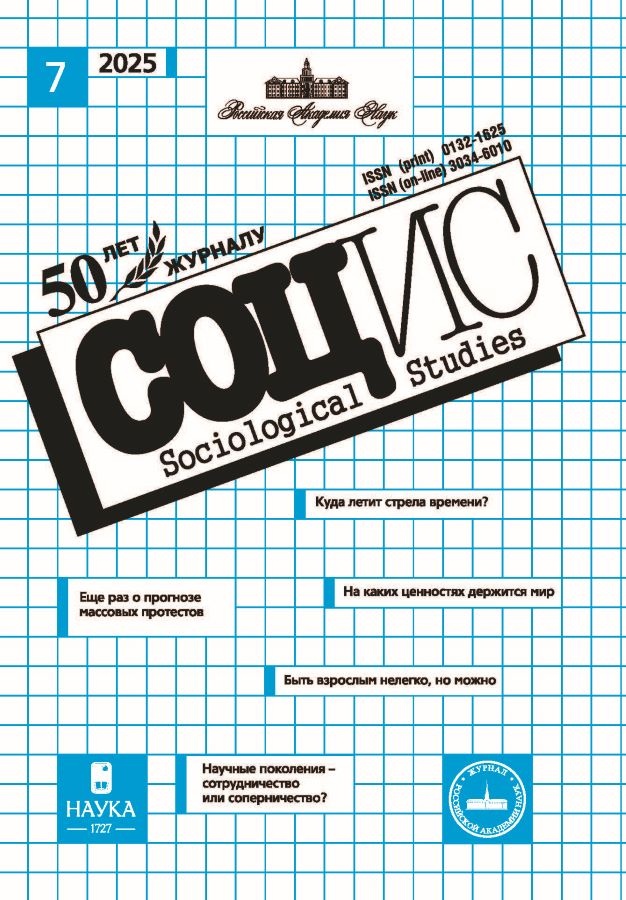Динамика установок россиян по отношению к иммигрантам: результаты анализа данных европейского социального исследования за 2006–2021 гг.
- Авторы: Воронина Н.С.1
-
Учреждения:
- Институт социологии ФНИСЦ РАН
- Выпуск: № 8 (2024)
- Страницы: 61-78
- Раздел: ЭКОНОМИЧЕСКАЯ СОЦИОЛОГИЯ. СОЦИОЛОГИЯ ТРУДА
- URL: https://edgccjournal.org/0132-1625/article/view/661802
- DOI: https://doi.org/10.31857/S0132162524080059
- ID: 661802
Цитировать
Полный текст
Аннотация
Работа посвящена анализу динамики установок россиян по отношению к иммигрантам на основе данных Европейского социального исследования (ESS) с 2006 по 2021 г. На протяжении 15-летнего периода преобладают негативные оценки вклада иммигрантов в экономику, культуру, в жизнь нашей страны. При этом россияне одобряют переезд в Россию этнически «своих» иммигрантов. Большинство респондентов выступают за переезд некоторых этнически «чужих» иммигрантов и иммигрантов из более бедных стран в Россию, причем с 2018 г. наблюдается тенденция к увеличению доли россиян, поддерживающих их переезд в нашу страну. Установки по отношению к иммигрантам остаются стабильно негативными среди женщин в возрасте 60 лет и старше, проживающих в малых городах, с начальным/незаконченным средним образованием, вдовых и разведенных. Выявленные тенденции требуют уточнения в дальнейших исследованиях.
Ключевые слова
Полный текст
Об авторах
Наталья Сергеевна Воронина
Институт социологии ФНИСЦ РАН
Автор, ответственный за переписку.
Email: navor@bk.ru
кандидат социологических наук, ведущий научный сотрудник
Россия, МоскваСписок литературы
- Арутюнян Ю. В., Дробижева Л. М., Сусоколов А. А. Этносоциология. М.: Аспект-Пресс, 1999.
- Воронина Н. С. Динамика отношения к миграции в России (по данным Европейского социального исследования за 2006–2016 гг.) // Социологическая наука и социальная практика. 2019. Т. 7. № 2. С. 99–116. doi: 10.19181/snsp.2019.7.2.6412.
- Воронина Н. С. Отношение к иммигрантам в период пандемии COVID-19 (2020–2021 гг.) // Социологическая наука и социальная практика. 2023. Т. 11. № 1. С. 104–123. doi: 10.19181/snsp.2023.11.1.6. EDN GIOGqE.
- Инлхарт Р. Постмодерн: меняющиеся ценности и изменяющиеся общества // Политические исследования. 1997. № 4. С. 6–33.
- Карачурина Л. Б., Мкртчян Н. В. и др. Миграционные процессы в России: тенденции, их интерпретация, новые подходы к статистическому наблюдению. М.: НИУ ВШЭ, 2020.
- Малахов В. С. Интеграция мигрантов: Концепции и практики. М.: Ф-д «Либеральная Миссия», 2015.
- Монусова Г. А. Отношение к мигрантам: мнения и сомнения россиян // Мониторинг общественного мнения: экономические и социальные перемены. 2021. № 6. С. 436–458. doi: 10.14515/monitoring.2021.6.2139.
- Мукомель В. И. Ксенофобы и их антиподы // Мир России. Социология. Этнология. 2017. № 1. 32–57.
- Тихонова Н. Е., Дудин И. В. Основные противоречия российского общества в восприятии населения страны: сравнительная значимость, динамика, факторы // Социологическая наука и социальная практика. 2023. Т. 11. № 2. С. 6–24. doi: 10.19181/snsp.2023.11.2.1. EDN: HGVOFG.
- Якимова О. А., Меньшиков А. С. Динамика отношения к иммигрантам в России в контексте ее сравнения с европейскими странами // Известия УрФУ. Сер. 3. Общественные науки. 2019. Т. 14. № 2/188. С. 46–61. doi: 10.21684/2587-8484-2020-4-4-22-40.
- Allport G. The Nature of Prejudice. Garden City, NY: Doubleday Anchor Books. 1958.
- Berg J. A. Race, Class, Gender, and Social Space: Using an Intersectional Approach to Study Immigration Attitudes // Sociological Quarterly, 2010. Vol. 51(2). P. 278–302. doi: 10.1111/j.1533-8525.2010.01172.x.
- Blumer H. Race Prejudice as a Sense of Group Position // Pacific Sociological Review. 1958. Vol. 1. P. 3–7.
- Kustov A., Laaker D., Reller C. The Stability of Immigration Attitudes: Evidence and Implications // Forthcoming in Journal of Politics. 2019. URL: https://ssrn.com/abstract=3322121 (дата обращения: 05.05.2024).
- Meuleman B., Davidov E., Billiet J. Changing Attitudes toward Immigration in Europe, 2002–2007. A Dynamic Group Conflict Theory Approach // Social Science Research. 2009. Vol. 38(2). P. 352–365.
- Mitchell J. Context and Change: A Longitudal Analysis of Attitudes about Immigrants in Adolescence // Socius: Sociological Research for a Dynamic World. 2019. Vol. 5. P. 1–11. doi: 10.1177/2378023119855157.
- Pettigrew T. F., Tropp L. R. A Meta-analytic Test of Intergroup Contact Theory // Journal of Personality and Social Psychology. 2006. Vol. 90(5). P. 751–783.
- Tajfel H., Turner J. et al. An Integrative Theory of Intergroup Conflict // Organ. Identity. Read (Porto Alegre). 1979. Vol. 18, P. 56–65.
- Yamagata M., Teragushi T. The Relationship Between Infection-Avoidance Tendencies and Exclusionary Attitudes Toward Foreigners: A Panel Study of the COVID-19 Outbreak in Japan // PsyArXiv. 2020. URL: https://psyarxiv.com/x5emj/ (дата обращения: 05.05.2024).
Дополнительные файлы

















